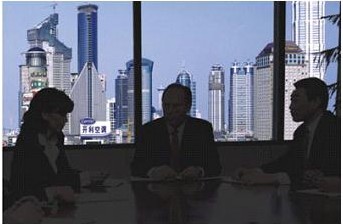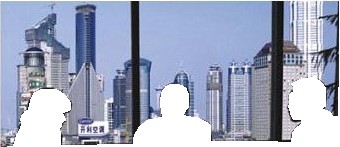See the picture and tell the story. What is a wide dynamic camera?
The camera has been technically quiet for a while. The infrared all-in-one machine has been fired for so long. The seller is very happy. The blower also blows to the sky. The person who uses it also scolds the sky. Anyway, it ’s like this. Writing something, I couldn't find a theme. Fortunately, the hype theme of various manufacturers recently moved to two projects: "Wide Dynamic" and "Low Illumination", so hurry to write something to let everyone have a preliminary understanding. Let's talk about "wide dynamics" first.
In fact, "wide dynamic" and "low illumination" are not new technologies or concepts. This is the goal that the camera has been pursuing for a long time. Unfortunately, all the points are still in the hands of the Japanese. We analyze the same:
Wide dynamic camera:
The so-called wide dynamic is to focus on solving the problems caused by the backlight environment. Let's take a look at sdyanfeng's picture

When the camera is backlit, because the overall light input is too large (the light outside the window is too strong), in order to avoid overexposure, the shutter speed will increase, which causes the background (high brightness area) to be normal, but the main body (low brightness area) is exposed The deficiency is therefore hacked.
Phenomenon 1: The metering is a whole metering, and now it is a high-speed shutter. Subject is underexposed, background exposure is correct
But we mainly want to see the people in the house. The scenery outside the window is really not important for monitoring. How to solve this problem? It is to change the metering area! There is a function in the DSP, which is to specify the metering range. He will set it in the middle 1/9 block, or add the following 1/3 to form a convex shape.

DSP uses this block to measure light, because the light in this block is dark, so the shutter speed is reduced, resulting in normal exposure in this block, but overexposure outside the window, as shown below:

Phenomenon 2: metering is area metering, now it is a slow shutter speed, the subject is exposed correctly, the background is overexposed
Speaking of which, some people will say: "Isn't this the backlight compensation!" Yes, it is the backlight compensation, what does it have to do with wide dynamic?
Ha ha! The so-called wide dynamic is to be able to have the advantages of the two pictures above, and expose the subject and the background to normal.
Just like the picture below.

How can this effect be achieved?
Anyone who knows computers will know that if you have a high-shutter and a low-shutter one, you can get it together and cut the background of the high-shutter one.

Then cut the background of the lower shutter

Two plus one:

This is not done!
Of course, you ca n’t use the mouse to get it bit by bit, it ’s too late, so you have to write a software to automatically judge the lightness and darkness, automatically take the necessary pictures, add them up automatically, and the most important thing is to process 25 frames per second, Open another DSP, and wrap the software and hardware together, it becomes a "wide dynamic DSP."
Here, we learned: "Wide-motion images must have a dedicated DSP, and the images are" made "!"
With the DSP, the question is coming again, where to find a picture with a low shutter and a high shutter for processing?
Use two CCDs? One high shutter and one low shutter? That won't work! It's impossible to adjust the angle at any angle.
The solution is to use a CCD, but each of the above points is exposed twice in a single time, one long exposure (low shutter) and one short exposure (high shutter), so each point has two data outputs, called "" "Double output CCD", because there are two data outputs at each point, the total amount of data is doubled than the general CCD, so the transmission speed must be doubled to move the data out, so it is also called "double speed CCD ( Double Speed ​​CCD).
That's it! The dual-output CCD threw a long-exposure and short-exposure signal to the DSP. The DSP performs the calculation and adds up. The so-called "wide dynamic camera" comes out.
This method was developed by Panasonic 10 years ago, but there is a problem with the name after it is done. The term "Wide Dynamic" has been used by some people before, and it is not uncommon to use it again, so Just change the name to "Super-Dynamic" (SD).
As mentioned above, this wide dynamic effect is made, so there are some problems in the early stage, such as the inability to process in real time (with some delay), the wisdom that cannot be processed at the intersection of light and dark (with burrs), the image is unnatural ("Made out") Wait ... After continuous improvement and the introduction of new DSPs, there are so-called SDII, SDIII, (which is the second and third generation!), Of course, all are Panasonic, and its DSP is not sold out, and all manufacturers can only stare!
Until these few years, Sony introduced the so-called SS-2 DSP and Double Speed ​​CCD, only manufacturers can use it to do it, but Sony still maintains its traditional tradition: DSP is very difficult to handle! And two DSPs are needed to achieve wide dynamic The function also needs to add a menu (OSD), so of course it is expensive to sell, pay more for those money, get those effects, it is worth watching people if it is not worth it.
Therefore, in addition to Panasonic's "super dynamic", the so-called "wide dynamic" CCD cameras on the market are almost all SONY SS-2 solutions, and two DSPs are required.
Also, because the "total" exposure time of each point of the CCD is fixed, it must be equipped with an automatic iris lens.
Speaking of which, we can't help but talk about the PIXIM solution. In this forum, there have been many introductions of PIXIM. It uses a C-MOS and an ARM9 processor in the DSP. From the data, it is transparent. By changing the AGC of each point on the C-MOS to achieve this effect (the real situation is still to be confirmed by the experts), so the early PIXIM also has the disadvantage of unnatural images (also "made"), and there is C -MOS is inherently poor in illumination, and the image will not be real-time in low light (frame accumulation), but it is true that PIXIM has been continuously improving in the past few years, because in our case, if we want to engage in PIXIM, we have to pay a premium, which Provide all the solutions, just follow the instructions. The challenge is too low. I still have n’t done it yet (actually, I ca n’t bear the royalties, huh!)
Therefore, there are basically only three types of so-called wide dynamic machines: Panasonic SDIII, Sony SS-2 solution and PIXIM C-MOS solution.
The previous pictures are just schematic diagrams used for explanation. It is not possible to achieve that effect in actual use. It is impossible to use a wide dynamic camera as a panacea. Pay more money to get those effects. It ’s up to people to see if it ’s not worth it.
Air conditioning refrigeration now generally uses water, ammonia, carbon dioxide, R12, R22, R134a, R404, R407C, R410 and R600a refrigerants. After 2009, Gree used R290, Jiabing, Zhongwei Refrigeration Company launched R433b, Furui Refrigeration Company launched ER445 series refrigerants, which are more energy-saving, environmentally friendly and efficient refrigerants, commonly known as hydrocarbon refrigerants, non-toxic, and will not cause any damage to the ozone layer. But because they are all alkanes, they are both flammable and explosive. Fluoride is a non-toxic, harmless, non-irritating, non-flammable, non-explosive, non-flash point, environmentally friendly refrigerant with 0 ODP value and very low GWP value.
Refrigerant For Air Conditioning
Air Conditioner Refrigerant,Fluorocarbon Liquid For Air Conditioning,Refrigerants Used In Air Conditioning,Refrigerant For Air Conditioning
Guangdong Giant Fluorine Energy Saving Technology Co.,Ltd , https://www.tuwtech.com
